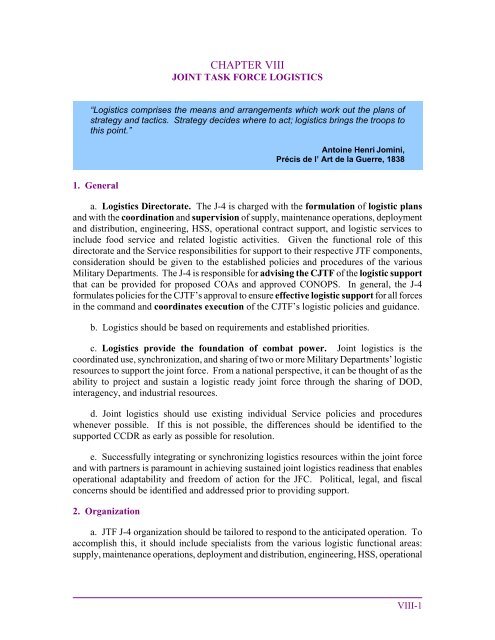JP 3-33, Joint Task Force Headquarters - Defense Innovation ...
JP 3-33, Joint Task Force Headquarters - Defense Innovation ...
JP 3-33, Joint Task Force Headquarters - Defense Innovation ...
You also want an ePaper? Increase the reach of your titles
YUMPU automatically turns print PDFs into web optimized ePapers that Google loves.
CHAPTER VIII<br />
JOINT TASK FORCE LOGISTICS<br />
“Logistics comprises the means and arrangements which work out the plans of<br />
strategy and tactics. Strategy decides where to act; logistics brings the troops to<br />
this point.”<br />
Antoine Henri Jomini,<br />
Précis de l’ Art de la Guerre, 1838<br />
1. General<br />
a. Logistics Directorate. The J-4 is charged with the formulation of logistic plans<br />
and with the coordination and supervision of supply, maintenance operations, deployment<br />
and distribution, engineering, HSS, operational contract support, and logistic services to<br />
include food service and related logistic activities. Given the functional role of this<br />
directorate and the Service responsibilities for support to their respective JTF components,<br />
consideration should be given to the established policies and procedures of the various<br />
Military Departments. The J-4 is responsible for advising the CJTF of the logistic support<br />
that can be provided for proposed COAs and approved CONOPS. In general, the J-4<br />
formulates policies for the CJTF’s approval to ensure effective logistic support for all forces<br />
in the command and coordinates execution of the CJTF’s logistic policies and guidance.<br />
b. Logistics should be based on requirements and established priorities.<br />
c. Logistics provide the foundation of combat power. <strong>Joint</strong> logistics is the<br />
coordinated use, synchronization, and sharing of two or more Military Departments’ logistic<br />
resources to support the joint force. From a national perspective, it can be thought of as the<br />
ability to project and sustain a logistic ready joint force through the sharing of DOD,<br />
interagency, and industrial resources.<br />
d. <strong>Joint</strong> logistics should use existing individual Service policies and procedures<br />
whenever possible. If this is not possible, the differences should be identified to the<br />
supported CCDR as early as possible for resolution.<br />
e. Successfully integrating or synchronizing logistics resources within the joint force<br />
and with partners is paramount in achieving sustained joint logistics readiness that enables<br />
operational adaptability and freedom of action for the JFC. Political, legal, and fiscal<br />
concerns should be identified and addressed prior to providing support.<br />
2. Organization<br />
a. JTF J-4 organization should be tailored to respond to the anticipated operation. To<br />
accomplish this, it should include specialists from the various logistic functional areas:<br />
supply, maintenance operations, deployment and distribution, engineering, HSS, operational<br />
VIII-1

















